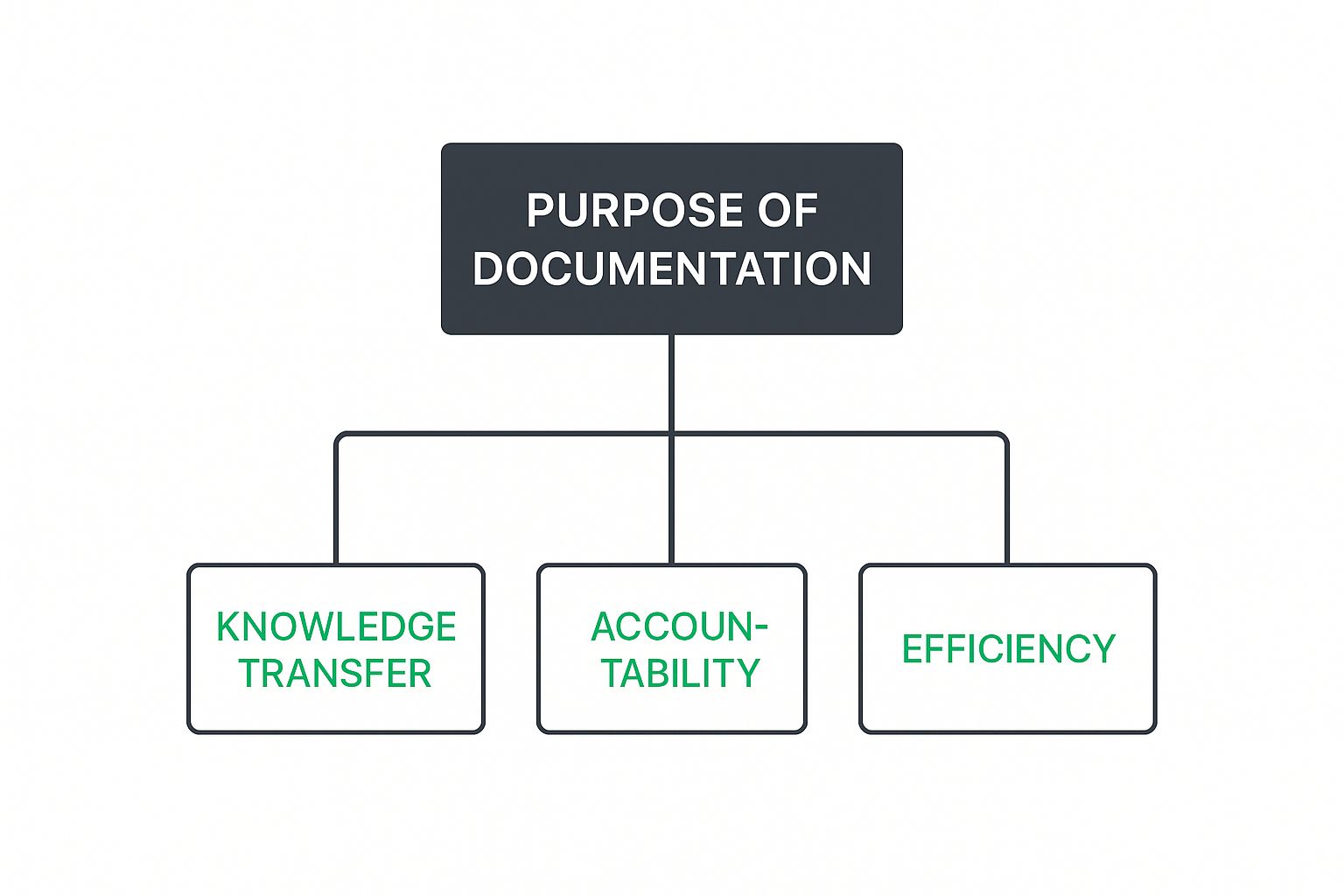Discover the real purpose of documentation for modern teams. Go beyond record-keeping to see how it drives efficiency, onboarding, and sustainable growth.
Let’s be honest—most people see documentation as a necessary evil. A chore. Something you have to do, not something you want to do. But what if we’ve been looking at it all wrong?
The real purpose of documentation isn’t just to “write things down.” It’s to create a single source of truth that keeps your teams aligned, protects your most critical knowledge, and ultimately, fuels scalable growth. When done right, it stops being an administrative headache and becomes the operational backbone of your entire organization.
Think of documentation less like a dusty old manual and more like a ship’s logbook. A captain doesn’t just jot down notes for history’s sake. That logbook is a live, critical tool for navigating storms, coordinating the crew, and charting the course for the next voyage.
That’s precisely what great documentation does for a business. It’s a reliable, living record that helps everyone make smarter decisions and operate more effectively. This is why more and more companies are treating their documentation like a core asset, not an afterthought. They’re investing in specialized tools because they understand that clear workflows and responsibilities are the bedrock of consistency and accountability. For a deeper dive into this trend, the business process documentation tools market report highlights just how crucial this has become.
So, what makes documentation truly valuable? It all comes down to three fundamental pillars that work together to support your entire organization.
This isn’t just theory; it’s a practical framework for building a smarter, more resilient team. This infographic really brings these functions to life, showing how they connect to create a central hub for organizational intelligence.

As you can see, knowledge transfer, accountability, and efficiency aren’t just buzzwords—they are the direct results of a healthy documentation culture. To see how this foundation applies in practice, check out our complete guide on what strategic documentation is.
To put it simply, here’s how these core functions translate into real-world business value.
Ultimately, investing in these functions isn’t just about creating documents; it’s about building a more self-sufficient, scalable, and intelligent organization.

Think of effective documentation as a silent partner on your team—a force multiplier working in the background to streamline how everything gets done. The most immediate wins are usually felt in two key places: getting new hires up to speed faster and cutting down on the daily interruptions that plague your senior developers.
It’s a powerful one-two punch that creates a virtuous cycle of productivity.
Picture a new engineer joining the team. Without solid documentation, their first few weeks are a blur of asking the same questions over and over. “How do I set up my environment?” “What are our coding standards?” “Where’s the guide for deployment?” This doesn’t just slow them down; it actively drains the focus of the experienced developers who have to stop what they’re doing to answer.
Now, imagine that same engineer has access to a well-tended knowledge base from day one. They can find setup instructions, understand the project’s architecture, and start contributing real code in days, not weeks. This is what we mean by making a team more self-sufficient. It empowers new people right away.
This simple shift turns onboarding from a huge time sink into a smooth, repeatable process. Your team can actually grow without productivity taking a nosedive.
Good documentation does more than just help new folks. It’s a fantastic tool for breaking down knowledge silos. When critical information only exists in the heads of a few senior experts, those people become bottlenecks. Every small question or system query gets routed to them, creating a constant stream of “quick questions” that shatter deep focus.
This is why its impact is felt across entire organizations, not just in engineering. For instance, 62% of sales teams rely on digital documentation to get better access to data, and 57% of marketing teams use it to automate their workflows. While HR adoption sits lower at 28%, its use there makes a huge difference in record-keeping and compliance. For a deeper dive, check out these recent document management statistics that show how different business functions benefit.
Let’s be honest, one of the biggest risks in any software team—one we don’t talk about enough—is losing knowledge. It happens all the time. A senior dev walks out the door, a project gets handed off to a new team, or the reasoning behind a critical decision gets lost in the mists of time. Suddenly, you’re stuck, trying to piece everything back together from scratch.
This institutional memory, all that hard-won experience, is your team’s most valuable asset. The problem is, it’s completely intangible. Without a system to capture it, you’re constantly fighting collective amnesia.
This is where documentation truly shines. Think of it as the architectural blueprints for your software. You wouldn’t try to renovate a skyscraper without them, right? You’d have no idea where the load-bearing walls are, why the plumbing runs a certain way, or how to add a new floor without the whole thing collapsing. Documentation does the exact same job for your projects.
Really great documentation goes beyond just describing what was built. It digs into the why. This context is everything.
When a new engineer joins the team, a well-documented architectural decision record is a lifesaver. It tells them about the trade-offs and constraints that led to the current system design. This stops them from accidentally breaking something important or wasting weeks going down a path the team already learned was a dead end.
The same goes for incident post-mortems. They aren’t just reports to file away. They are powerful learning tools that break down what went wrong, how the team fixed it, and what’s being done to prevent it from happening again. A painful outage is transformed into a lesson that makes the entire team stronger.
This act of preservation is fundamental to your company’s long-term health. It’s how you protect your intellectual property and build a stable foundation for future growth and maintenance. Without it, every code change is a gamble and every person leaving is a potential crisis.
By taking the time to document your collective knowledge, you’re making a direct investment in your team’s future. You’re empowering them to stand on the shoulders of past work instead of constantly having to rediscover it.

Beyond just keeping track of what you’ve built, a core purpose of documentation is to lay the groundwork for growing your operations and, eventually, automating them. It’s a simple truth: you can’t automate a process that hasn’t been clearly defined, measured, and written down.
Think of it like this. A perfectly documented customer support workflow is the blueprint for a smart, effective chatbot. A detailed engineer’s runbook for deploying a new service contains the exact script an automated deployment pipeline needs to follow. Documentation isn’t just for human eyes; it’s the structured instruction manual that machines need to do their jobs correctly.
This link becomes crystal clear when you look at something like Intelligent Document Processing (IDP). Businesses everywhere are trying to automate tedious jobs like managing invoices and entering data. A recent McKinsey global survey found that 70% of companies are already testing automation for these kinds of document-heavy workflows. What’s more, nearly 90% plan to do even more.
This trend really shines a light on how crucial documentation is for turning messy, unstructured information into clean data that automation tools can actually use. You can dive deeper into this shift by checking out the full report on the intelligent document processing market.
What this really means is that every Standard Operating Procedure (SOP) you write, every API endpoint you define, and every system diagram you draw is a direct investment in your company’s future. It’s the raw material needed to scale effectively.
For software teams, the connection is even more direct. Clear documentation in software development is what makes automated testing, integration, and deployment possible. It’s the very foundation of modern CI/CD practices. This systematic approach slashes manual errors and, more importantly, frees up your developers to build cool new features instead of getting bogged down by repetitive tasks.
Knowing why you need documentation is one thing, but actually building a team culture that produces it consistently? That’s a completely different ballgame. The real goal is to create “living documents”—resources so genuinely useful they become a natural, indispensable part of your team’s daily workflow, not just another bureaucratic box to check. This means shifting your mindset away from exhaustive, wordy tomes and toward intentional, laser-focused clarity.
Great documentation always starts with a specific audience in mind. Think about it: a guide for a junior developer just trying to get their bearings in a new service will look radically different from an architectural decision record meant for senior engineers. When you tailor the content, you ensure it answers the reader’s most urgent questions without burying them in noise.
This targeted approach is also what keeps documentation from going stale. When a document tries to be everything to everyone, it ultimately fails to serve anyone well and gets abandoned.
To make sure your documents stay “alive,” they need clear owners and have to be wired directly into your development process. This is where a practice like Docs-as-Code really shines. By treating your documentation just like your code—storing it in a repository, versioning it, and including updates in pull requests—you make it a tangible, non-negotiable part of the development cycle.
This creates a natural rhythm for maintenance. For example, when a developer adds a new API endpoint, the “definition of done” for that task must include updating the corresponding API documentation. It’s a simple, powerful habit that prevents the all-too-common problem where the code and the docs drift apart, slowly eroding everyone’s trust in your resources. A great guide on how to write test cases offers a perfect parallel, showing how specific, actionable instructions serve a crystal-clear purpose.
Ultimately, building these habits boils down to a commitment to a few core principles:
By adopting these strategies, you can transform documentation from a static, neglected artifact into a dynamic asset that actively helps your team build better software. For more concrete advice on making this happen, you can dig into these software documentation best practices that help lock these habits in for good.

Even when everyone agrees documentation is important, putting it into practice brings up a lot of questions. Getting the team on the same page about the “how” is just as critical as understanding the “why.” Let’s tackle some of the most common hurdles teams face.
The main point of documentation is to create clarity. But that clarity comes in different flavors, each designed for a specific audience and purpose.
Broadly speaking, documentation splits into two major camps: what you show your users and what you show your team.
While one is external and the other is internal, they both aim to create a single source of truth. This alignment prevents confusion, whether it’s for a customer trying to use a feature or a developer trying to build one.
Forget top-down mandates and nagging. Real motivation comes when your team sees documentation for what it is: a tool that makes their jobs easier, not another chore to check off.
First, you have to lead by example. Show, don’t just tell, how clear docs cut down on repetitive questions and speed up development cycles.
Second, weave it directly into your workflow. A simple but powerful rule is making “update the docs” part of your team’s “definition of done” for any task. Finally, give them tools that make it dead simple, integrating documentation right where they already work.
The sweet spot is “as lean as possible but as complete as necessary.” The goal is usefulness, not volume. You’re not trying to write a novel.
Start by documenting the why behind big decisions—like the architectural choices that will impact the team for years. Focus on tricky business logic that isn’t obvious from reading the code itself. And, of course, document the essential procedures for onboarding new hires, troubleshooting common problems, and recovering from disasters.
Good documentation eliminates future work. It’s not about describing every single line of code; it’s about giving your future self (and your teammates) the context they’ll need to move forward.
Ready to stop wasting time on manual documentation? DocuWriter.ai uses AI to automatically generate clear, accurate code and API documentation, freeing your engineers to focus on what they do best—building great software. See how much time you can save at https://www.docuwriter.ai/.